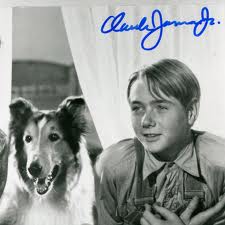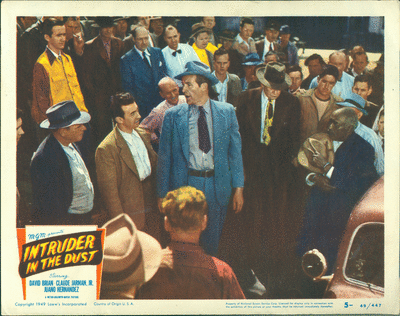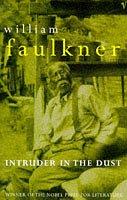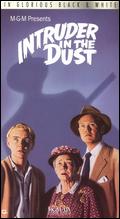Clarence Brown’s film Intruder in the Dust is a fantastic rendition of William Faulkner’s novel of the same title. Juano Hernandez delivers a powerful performance as Lucas Beauchamp. In my opinion, I think the film’s spotlight is centered on Lucas instead of Chick from Hernandez’s stand alone performance. This is a significant difference from the novel because in the film the world we perceive is not mediated through Chick’s dominating, narratorial consciousness. From novel to film, the focal emphasis has shifted from a white to a black racial perspective.


Chick Mallison is played by Claude Jarman Jr. Even though Jarman is a young actor and his acting skills may not have developed fully at the time, his performance of Chick is weak. At times it appears as though he is uncertain if he is on the correct filming set, which is a harsh criticism but honest nonetheless. What adds insult to injury is the outperforming of a white character by a black character. Hernandez’s Puerto Rican ethnicity, however, makes this a little less hard to swallow for the white audience. If he was an African American actor residing in the US then public reactions to the film-especially in the South because Southerns were apprehensive about having a film about lynching made on location-may have taken a turn for the worst. This is one of the many hints in the film of the race relations in the then current sociopolitical context of the American South.

Another example of the race relations that leaks through in the adaptation from novel to film is evident from Elzie Emanuel’s performance of Aleck Sander. In the novel, Faulkner depicts Aleck Sander as possessing practical intelligence, which is apparent from his closeness to nature, his ability to improvise when there is only one shovel present by using a plank of wood to dig with in the graveyard scene, his handling of the horse, Highboy, his ability to spot a mule coming towards them in the dark of night, and his knowledge of the presence of quicksand. Faulkner juxtaposes Aleck with Chick who posses intellectual intelligence. However, both characters compliment each other because the intelligence that one lacks is supplemented by the other. In this sense, they may be interpreted as alter-egos of each.

On the other hand, in the film, Elzie Emanuel was forced to perform Aleck Sander in the stereotypical manner of the comic, coon figure with bulging, bug eyes and dialogue that implies his dim-wittedness. Aleck’s give-and-take relationship with Chick in the novel becomes a give-and-give relationship in the film because of his subservient role as Chick’s black servant. This is apparent in the graveyard scene where Chick calls the shots and Aleck does what he is told in a passive, servile manner. Brown establishes the postion of Aleck’s social status in relation to Chick in the flashback sequence at the start of the film that recalls Chick’s African-American cultural experience at Lucas’s house after in fell into the creek. In this scene, Chick attempts to transform Lucas’s moral deed into a financial deed that is fulfilled by a monetary transaction when he offers Lucas money. Lucas refuses to subvert the decency of his hospitality by refusing to accept Chick’s money. Chick fails to realise the lesson-some deeds cannot be paid for- Lucas is trying to teach him. Chick retaliates by attempting to exercise his power over Lucas from his position in the racial hierarchy of the white hegemonic society of the South. Chick does this by dropping the coins he has offered Lucas. There is a close-up of Chick’s white hand as he drops the coins on the floor. The camera follows the trajectory of one of the rolling coins with a close up of it, which conveys the dramatic intensity of the moment. Lucas responds by demanding Aleck Sander to pick up the coins and to return them to Chick. It is in this shot, when Aleck is in a state of genuflection-a position of deep respect for a superior-that Chick’s superior status over Aleck becomes visually solidified in our memory.
The significance of the recurrent motif of hands in the film also reinforces Chick’s relationship to Aleck, which in many ways is a microcosmic depiction of America’s race relations. The close-up shot of Aleck’s black hand positioned above Chick’s as he places the money in to Chick’s hand suggests his aforementioned servile role and Aleck’s give-and-give relationship with Chick, but it may also be interpreted as suggesting the economy of slavery and black subjugation. The rise and development of the South may be attributed to slavery. Slave plantations were a capitalist enterprise, which were highly profitable. Owning slaves in the South was an advantageous strategy because slaves were used as field hands to pick cotton, the staple crop of the South and while cotton was not being harvested they were used to grow corn, which further supplemented their wealth. Therefore, the act of a black character putting money in the hand of a white character is reminiscent of the Antebellum South when slavery generated money.
In a similar vein, the hand motif is also indicative of Chick’s relationship to Lucas. In the second jail scene when Chick returns to Lucas’s cell to talk to Lucas alone, there is a close-up shot of Lucas’s black and Chick’s white hands clutching either side of the cell door. The rapid cross-cutting of the camera angles from inside and outside of the cell obscures one’s ability to differentiate between either one. This camera work implies the disintegration of the divisions between captivity and freedom and guilty and innocence. Therefore, despite being outside the cell, Lucas is imprisoned also because he is in a psychological prison constructed and imposed on him by the racist society he lives in.
Also the camera only displays certain parts of Lucas and Chick which implies that they can only see and understand each other to a certain extent. The cell door that divides them and disrupts their comprehension of each other could be interpreted as a physical representation of the social mores and codes preventing proper race relations.

Furthermore, Lucas’s prison does not only serve the purpose of incapacitation for societal protection. Instead, the prison cell protects him from societal retribution by means of lynching. This inversion of the main method of criminal punishment and justice suggests the perversion of justice in this society as innocent people are imprisoned to protect them from the guilty people who are free to orchestrate a lynch mob outside. Critics contend that the deflation of justice is conveyed at the start of the film from the flat tire of the sheriff’s car. This is evident in the film from the shot of Crawford Gowrie standing under the tree with a lit match in hand after Chick, Stevens and the Sheriff arrive at the prison. The cut to the inside of the prison establishes a juxtaposition between both. It is also apparent when the lynch mob has gathered outside the prison and Crawford approaches with a Jerry can of petrol in hand.

The stand-off scene between Crawford and Miss Habersham is wrath with a high level of dramatic intensity as the preceding camera shots focused on the Jerry can in Crawford’s hand and the trail of petroleum spilling from it as he approached the prison entrance. This trail of petrol that leads back to its source-the petrol pump-may be interpreted as the consequences of Crawford’s actions. In order to intimidate Miss Habersham, Crawford splashes petroleum at her feet, and strikes a match-a recurring action, which is visible in practically every shot of him in the film. The camera focuses on Crawford as he holds the lighting match in hand. If he ignites the petrol that would burn the prison and Miss Habersham then his actions would backfire on him, and the fire he ignited would burn back to its source, causing an uncontrollable chain reaction of events that would culminate in his own death by lynching for committing the unforgivable act of unlawfully killing an innocent, white woman. However, the fire of the match, which may be interpreted as Crawford’s masculinity or his source of power is extinguished by Miss Habersham.
Consequently, the climax of the film also differs significantly from the novel. The novel culminates with Crawford’s suicide, which has been interpreted by critics as an evasion of the law. The film, on the other hand, attempts to emphasize that justice prevails while the sub-text of the film suggests otherwise, as evident from the aforementioned, second jail scene. The filming of Crawford Gowrie in the backseat of the Sheriff’s car-the same position of Lucas Beauchamp at the start of the film- demonstrates not only the cyclical structure of the film, but also the cyclicality of the history of America’s race relations as society realizes that those who were thought to be innocent are guilty and vice versa.








































































































